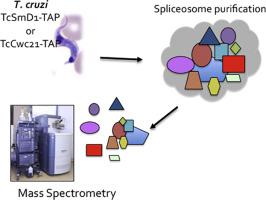当前位置:
X-MOL 学术
›
J. Proteomics
›
论文详情
Our official English website, www.x-mol.net, welcomes your
feedback! (Note: you will need to create a separate account there.)
Proteomic analysis of Trypanosoma cruzi spliceosome complex.
Journal of Proteomics ( IF 2.8 ) Pub Date : 2020-05-15 , DOI: 10.1016/j.jprot.2020.103822 Rosicler L Barbosa 1 , Julia Pinheiro Chagas da Cunha 2 , Arthur T Menezes 1 , Raíssa de F P Melo 3 , Maria Carolina Elias 2 , Ariel M Silber 3 , Patricia P Coltri 1
Journal of Proteomics ( IF 2.8 ) Pub Date : 2020-05-15 , DOI: 10.1016/j.jprot.2020.103822 Rosicler L Barbosa 1 , Julia Pinheiro Chagas da Cunha 2 , Arthur T Menezes 1 , Raíssa de F P Melo 3 , Maria Carolina Elias 2 , Ariel M Silber 3 , Patricia P Coltri 1
Affiliation

|
The unicellular protists of the group Kinetoplastida include the genera Leishmania and Trypanosoma, which are pathogens of invertebrate and vertebrate animals. Despite their medical and economical importance, critical aspects of their biology such as specific molecular characteristics of gene expression regulation are just beginning to be deciphered. Gene expression regulation also depends on post-transcriptional processing steps, such as the trans-splicing process. Despite being widely used in trypanosomes, trans-splicing is a rare event in other eukaryotes. We sought to describe the protein composition of spliceosomes in epimastigotes of T. cruzi, the etiological agent of Chagas disease. We used two TAP-tagged proteins to affinity purify spliceosomes and analyzed their composition by mass spectrometry. Among the 115 identified proteins we detected conserved spliceosome components, as Sm and LSm proteins, RNA helicases, U2- and U5-snRNP specific proteins. Importantly, by comparing our data with proteomic data of human and T. brucei spliceosome complexes, we observed a core group of proteins common to all spliceosomes. By using amino acid sequence comparisons, we identified RNA-associated proteins that might be involved with splicing regulation in T. cruzi, namely the orthologous of WDR33, PABPCL1 and three different HNRNPs. Data are available via ProteomeXchange with identifier PXD018776.
中文翻译:

克氏锥虫剪接体复合体的蛋白质组学分析。
动质体组的单细胞原生生物包括利什曼原虫属和锥虫属,它们是无脊椎动物和脊椎动物的病原体。尽管它们具有医学和经济重要性,但其生物学的关键方面,如基因表达调控的特定分子特征,才刚刚开始被破译。基因表达调控还取决于转录后加工步骤,例如反式剪接过程。尽管在锥虫中被广泛使用,但反式剪接在其他真核生物中是罕见的事件。我们试图描述 T. cruzi 的 epimastigotes 中剪接体的蛋白质组成,T. cruzi 是恰加斯病的病原体。我们使用两种 TAP 标记的蛋白质来亲和纯化剪接体,并通过质谱法分析它们的组成。在 115 种已鉴定的蛋白质中,我们检测到保守的剪接体成分,如 Sm 和 LSm 蛋白质、RNA 解旋酶、U2-和 U5-snRNP 特异性蛋白质。重要的是,通过将我们的数据与人类和 T. brucei 剪接体复合物的蛋白质组学数据进行比较,我们观察到所有剪接体共有的一组核心蛋白质。通过使用氨基酸序列比较,我们确定了可能与 T. cruzi 中的剪接调节有关的 RNA 相关蛋白,即 WDR33、PABPCL1 和三种不同的 HNRNPs 的直系同源蛋白。数据可通过 ProteomeXchange 获得,标识符为 PXD018776。我们观察到所有剪接体共有的一组核心蛋白质。通过使用氨基酸序列比较,我们确定了可能与 T. cruzi 中的剪接调节有关的 RNA 相关蛋白,即 WDR33、PABPCL1 和三种不同的 HNRNPs 的直系同源蛋白。数据可通过 ProteomeXchange 获得,标识符为 PXD018776。我们观察到所有剪接体共有的一组核心蛋白质。通过使用氨基酸序列比较,我们确定了可能与 T. cruzi 中的剪接调节有关的 RNA 相关蛋白,即 WDR33、PABPCL1 和三种不同的 HNRNPs 的直系同源蛋白。数据可通过 ProteomeXchange 获得,标识符为 PXD018776。
更新日期:2020-05-15
中文翻译:

克氏锥虫剪接体复合体的蛋白质组学分析。
动质体组的单细胞原生生物包括利什曼原虫属和锥虫属,它们是无脊椎动物和脊椎动物的病原体。尽管它们具有医学和经济重要性,但其生物学的关键方面,如基因表达调控的特定分子特征,才刚刚开始被破译。基因表达调控还取决于转录后加工步骤,例如反式剪接过程。尽管在锥虫中被广泛使用,但反式剪接在其他真核生物中是罕见的事件。我们试图描述 T. cruzi 的 epimastigotes 中剪接体的蛋白质组成,T. cruzi 是恰加斯病的病原体。我们使用两种 TAP 标记的蛋白质来亲和纯化剪接体,并通过质谱法分析它们的组成。在 115 种已鉴定的蛋白质中,我们检测到保守的剪接体成分,如 Sm 和 LSm 蛋白质、RNA 解旋酶、U2-和 U5-snRNP 特异性蛋白质。重要的是,通过将我们的数据与人类和 T. brucei 剪接体复合物的蛋白质组学数据进行比较,我们观察到所有剪接体共有的一组核心蛋白质。通过使用氨基酸序列比较,我们确定了可能与 T. cruzi 中的剪接调节有关的 RNA 相关蛋白,即 WDR33、PABPCL1 和三种不同的 HNRNPs 的直系同源蛋白。数据可通过 ProteomeXchange 获得,标识符为 PXD018776。我们观察到所有剪接体共有的一组核心蛋白质。通过使用氨基酸序列比较,我们确定了可能与 T. cruzi 中的剪接调节有关的 RNA 相关蛋白,即 WDR33、PABPCL1 和三种不同的 HNRNPs 的直系同源蛋白。数据可通过 ProteomeXchange 获得,标识符为 PXD018776。我们观察到所有剪接体共有的一组核心蛋白质。通过使用氨基酸序列比较,我们确定了可能与 T. cruzi 中的剪接调节有关的 RNA 相关蛋白,即 WDR33、PABPCL1 和三种不同的 HNRNPs 的直系同源蛋白。数据可通过 ProteomeXchange 获得,标识符为 PXD018776。











































 京公网安备 11010802027423号
京公网安备 11010802027423号